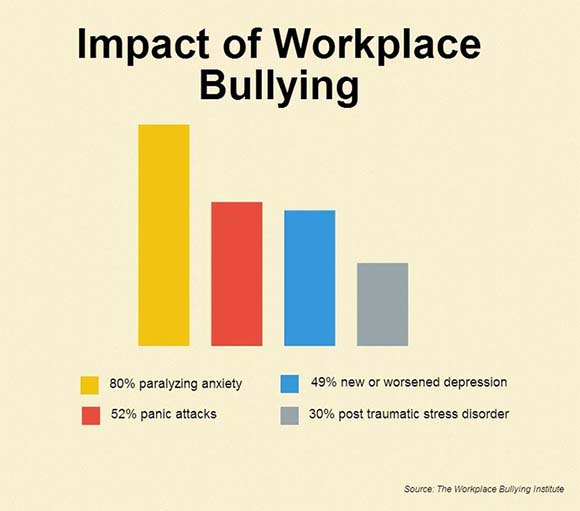In a world that seems increasingly polarized, business owners and managers need to be alert to the threat of employee harassment in the forms of bullying and mobbing in the workplace.

What is Bullying and Mobbing? Is it the Same Thing as Harassment?
Social interactions and the language we use to describe them keep changing over time.
If you were to take a poll 30 or 40 years ago asking people to provide a definition of the term bullying, most would describe something along the lines of an altercation on the playground at school – often leading to an uncomfortable visit to the principal’s office for a warning or threat of detention, followed by a strongly worded parent-teacher conference.

This expression, workplace bullying, encompasses a whole range of negative behaviors, instigated by either an individual or a group of employees against another employee.
Bullying in the workplace can lead to various forms of victimization, ranging from physical assault, verbal badgering (such as insulting remarks), emotional abuse, intimidation, aggression, psychological or sexual harassment, to negative social interactions, such as isolation, shunning or spreading false rumors to discredit an individual.
What about this term mobbing?
While workplace bullying or harassment are the predominant terms used in the U.S. and the U.K. to describe this type of malevolent behavior at work, another term for workplace bullying has emerged in other parts of the world — mobbing. It’s derived from the concept of mob rule, e.g. a crowd that engages in lawless, violent behavior directed against individual victims.
While the terms mobbing and bullying are generally considered equivalent, it’s more common to find the term mobbing used in scholarly works, government documents or among English-speakers outside the U.S. and the U.K. (particularly in Scandinavia and Australia, where there have been extensive campaigns to reduce workplace harassment.)
What are the Ways Bullying/Mobbing Negatively Impact Employee Development?
Companies invest a lot of time and resources recruiting, hiring, and training their employees, so from a purely economic cost basis, any instance of workplace bullying can be costly — from losing a valued employee to defending a labor law legal challenge brought by a victim (more on these business impacts later).
But for the employees that get singled out for harassment, workplace bullying can be devastating — with consequences ranging from a serious disruption to their path up the career ladder to more serious psychological complications that can even affect their mental and physical health.
Signs of workplace bullying can range from absenteeism, lack of organizational commitment, anxiety, depression, job burnout, to varying degrees of psychological distress.
In fact, some researchers contend that in extreme cases, victims of workplace bullying can be as psychologically and physically debilitated as those who have been diagnosed with PTSD (post-traumatic stress disorder) — such as military veterans, or those who have survived acts of terrorism or severe natural disasters.
What are the Risks to Business that Arise from Bullying/Mobbing in the Workplace?
If you are a business owner or a manager, and you haven’t given much thought to what can happen when you allow cases of workplace bullying to persist in the office, consider some of these potential negative consequences for your company:
Bullying at work can diminish both individual employee and overall project performance:
- Increased absenteeism of bullying victims
- Less commitment from employees who sense a hostile work environment
- Distraction to employees who ‘witness’ harassment, potentially leading to less focus on tasks / more mistakes and quality defects
- Project delays caused by reduced motivation, increased absenteeism, and/or employee turnover
Bullying at work can significantly increase management costs:
- Overall productivity decline due to perceived toxic work culture
- Management time spent intervening in bullying cases not caught early
- Expense of recruiting, training, and developing new employees to replace those lost to high turnover
Bullying at work can lead to a potentially severe negative impact on your customer reputation and/or leave you exposed to legal action:
- Potentially tarnished company reputation in the marketplace
- Negative impact on customer relationships
- Cost of defending potential lawsuits brought on by bullying victims
How Does Workplace Bullying Come About and What Can You Do If You Feel You are a Victim of Bullying?

1. Learn to recognize bullying behavior patterns and their underlying causes.
Are you being singled out from your peers and subjected to aggressive behavior by a colleague or manager?
Shouting, name-calling and derogatory comments are common signs of workplace bullying, particularly at lower level or entry-level positions. As one advances up the career ladder, workplace bullying often takes the form of actions designed to block career advancement; examples of these range from exclusion from project assignments that would lead to higher-level responsibilities to cases of constructive dismissal (where levels of harassment at work become so unbearable that the employee is compelled to quit).
What are the reasons for this behavior? Psychologists believe that in many cases, the underlying cause for the bullying behavior is actually insecurity and jealousy on the part of the instigator, which in turn, causes them to try to achieve perverse satisfaction by tormenting, controlling, or blocking the success and career advancement of their targeted victims.
2. Decide if this is just an unpleasant work situation or a true case of workplace bullying.
How can you be sure you are a target of bullying?
If you are truly being victimized at work, your friends and family or doctor may be the first to know.
Often, targets of bullying cannot stop talking about what is happening to them at work. Discuss the situation with trusted contacts outside of work to evaluate if you are truly being singled out for harassment or if the situation is just an unpleasant work situation.
As bullying victims often suffer from sleep deprivation, nausea, and dread about returning to work, a visit to your doctor may help diagnose health issues brought about by excessive stress at work, ranging from increased blood pressure to signs of PTSD.
3. Get your ducks in a row: be prepared for multiple outcomes.
Even though you didn’t choose the situation, you will need to take action. Don’t assume things will get better on their own over time; research indicates otherwise.
The sobering statistic from the Workplace Bullying Institute is that once you have been targeted for bullying, you have a 66% chance of losing your job.
Since it takes time to find new employment, lining up a new work opportunity should be very high on your priority list. Even if you don’t end up moving to another company, it’s better to be prepared.
You should also begin to document all interactions between yourself and the bully. If the harassment occurs via email, texting or social media, be sure to print out or save extra copies of these materials.
As hard as it may be, you need to avoid becoming emotional at work; be discreet with the information you are collecting at this stage.
If you are unsure how to proceed, consider having a preliminary consultation with an outside employment attorney.
Take care of your health. Eat right, exercise, and get enough rest. Get support from family and friends. Consult with your own physician or counselor if needed.
4. Confront the bully directly. If that’s not effective, make a business case to your boss and HR department for their removal.
This is possibly the hardest step. You need to confront the situation in a non-emotional manner.
You need to give each responsible party an opportunity to assist with correcting the situation.
Start by confronting the bully. Maintain a professional tone, while declaring to them that their behavior is inappropriate. Reinforce your words with strong body language, such a raising your hand to gesture ‘stop!’
A simple declaration, such as, “I think your comments to me are inappropriate,” is best. Avoid getting into an argument.
If the bully changes his or her behavior, reinforce the positive changes, but keep documenting and monitoring the situation.
If not, you need to take this issue to the next level — to your boss, or if the boss is the one bullying you — to another more senior person at the company. This time you need to make a sober, emotion-free business case argument that the status quo is not only unacceptable, it’s also economically detrimental to the company.
Don’t be surprised if the reaction is indecisive. Unfortunately, companies often promote bullies rather than fire them. Why? Managers might also be afraid of the bully, or they may choose to actively overlook bad behavior because they consider the employee in question to be ‘indispensable’ (”Oh, that’s just how Steve acts, he’s a bit aggressive at times, but this department couldn’t survive without him.”).
If you are still unsuccessful, you need to give the HR (human resources) professionals at your company one chance to intervene in the situation.
5. Accept the consequences and move on
If you are successful in negotiating a change in the organization that stops the workplace harassment, congratulations to you! Try your best to let go of any negative feelings, avoid discussing the details of the situation at work, and resume your career with renewed vigor.
If however, after unsuccessfully pursuing your grievance all the way up to the HR department, it’s most likely time to exit the company gracefully, secure in the knowledge you did your best to shine a light on the problem. Then, convert your pent up stress and frustration into positive energy at your next company.
How Companies Can Build a Healthy Culture that Confronts Workplace Harassment Pro-actively
1. Watch for indications of bullying behavior (Caution: they may come too late to take action)
Management needs to be on the lookout for signs of bullying behavior in the workplace. However, due to the very personal nature of bullying, many incidents of harassment occur in situations where they cannot be observed directly.
Sudden drops in quality of work, as well as a slow decline, can be indications of poor morale and motivation caused by bullying. Increased employee turnover can be another indication.
In one case, a department of fifty people, which normally had an annual turnover rate less than 5%, experienced a spike where 40% (nearly half) of the employees resigned during a 12-month period. A post-mortem revealed that the source of the problem was a line manager who bullied one employee after another. Unfortunately for the affected employees and the company, these metrics came to light far too late for upper management to intervene in time.
2. Be proactive: establish company values that promote teamwork over competition, with a zero tolerance policy for bullying
Instead of waiting for bullying issues at the workplace to show up as an employment statistic, company leadership needs to take a proactive approach.
Industrial psychologists recommend establishing core company values that promote collaboration and teamwork over individual competition — this is thought to reduce the incidence of bullying.
Executive management also needs to be crystal clear with all employees that there is zero tolerance for bullying in the workplace and that any incidents will be dealt with on the spot.
Employers also need to make employees aware that these rules of professional behavior extend to communications on social media platforms (as well as email and texting).
3. Establish an internal communication program to promote company values through town hall / all hands meetings
It’s not sufficient to have a core set of company values sitting on the shelf.
Company leadership needs to establish an effective internal communications program that emphasizes the importance of a healthy work environment that is free from harassment — as well as the organization’s strict policies on unacceptable behavior.
Depending on the size of your organization, you may want to establish an internal cascading communication program on preventing bullying, introduce on-going employee and management anti-bullying training, or conduct regular company-wide town hall / all hands meetings that reinforces the organization’s core values to make sure that every employee gets the message that bullying at the workplace is unacceptable.
Turn to Formaspace for Office Solutions
Our goal here at Formaspace is to build office furniture solutions that will help your office be a happier, healthier, and more productive place to work.
That’s why companies of all industry sectors, ranging from high-tech giants like Amazon, Google, and Twitter, finance leaders like CapitalOne, pharma and healthcare companies like GlaxoSmithKline and Quest Diagnostics, as well industrial manufacturing companies like 3M, Boeing, and Lockheed Martin to choose Formaspace furniture solutions.
Want to learn more? A Formaspace design consultant is just a phone call away.











